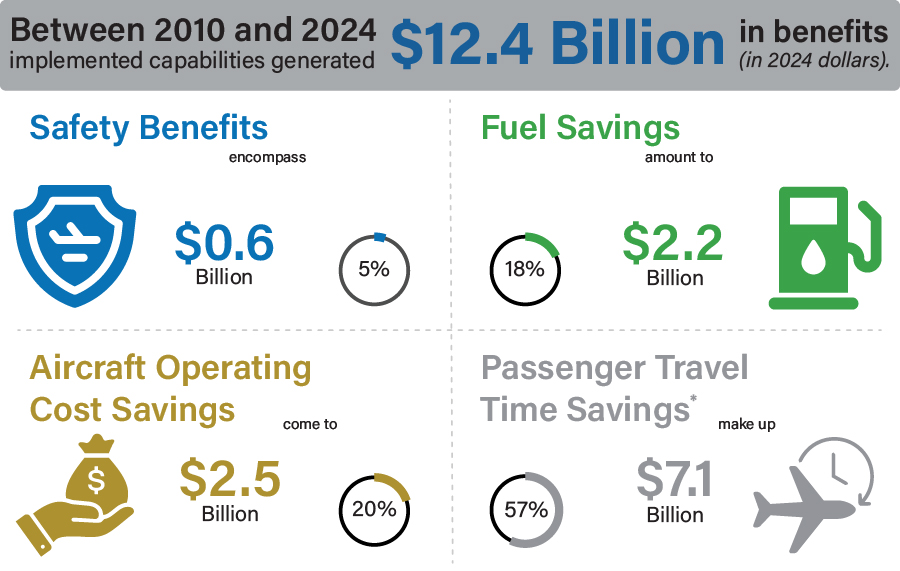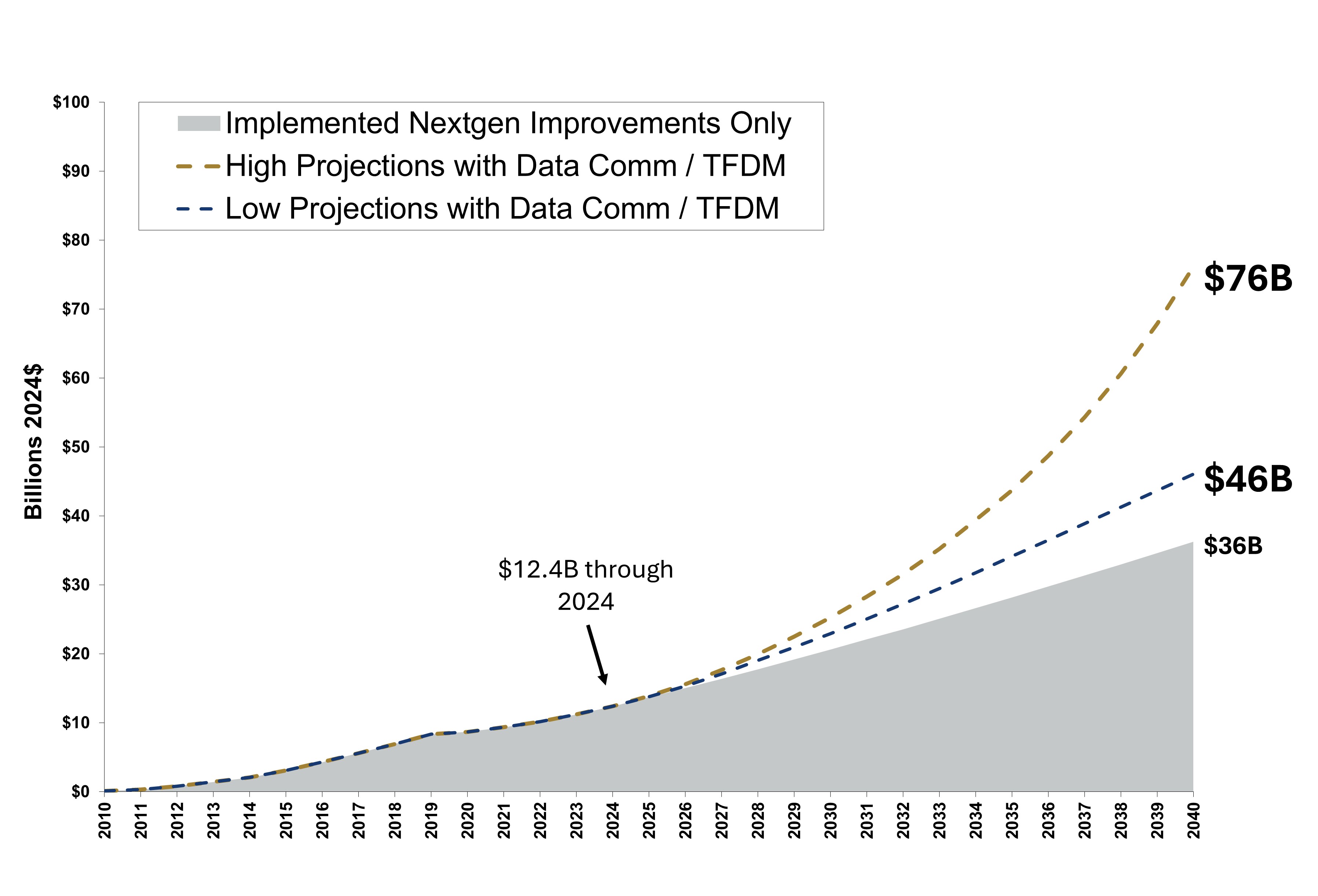Performance Reporting and Benefits
NextGen is vital to ensuring the National Airspace System (NAS) safely accommodates air traffic growth and new types of aircraft. It also supports aviation's essential role for Americans and the U.S. economy.
Improvements from new NextGen technologies, capabilities, and procedures realize benefits in safety, efficiency, and capacity. The benefits graphic below highlights the total benefits measured from more than 20 NextGen capabilities through more than 200 implementations across the nation. Fuel savings also mean lower carbon dioxide emissions.

* Per DOT guidance, the FAA values benefits using not only aircraft operating cost savings, but also passenger travel time savings.
Increase from 2023 to 2024
The benefits estimated from implemented NextGen programs increased from $10.9 billion in 2023 to $12.4 billion in 2024. The factors driving the increase were:
- Another year of benefits accrual from previous implementations added $1.1 billion.
- Metroplex implementations at additional sites added $24 million.
- • Inflating the values from 2023 to 2024 dollars contributed the remaining increase in benefits.
Year and Type
Of the estimated $12.4 billion in accrued benefits to the airlines and flying public, the graph below depicts benefits accrued each year from 2010 to 2024 by type of benefit.
NextGen continued to deliver benefits during the COVID-19 pandemic but at lower levels because of the drop in flights and congestion.
Many NextGen benefits result from improving a system under stress and experiencing delays. Early in the pandemic, airline flights sank to unprecedented low numbers, which resulted in dramatically reduced delays. NextGen implemented capabilities are focused on improving the NAS when demand approaches the capacity limits across the system. NextGen’s value is greater when demand is high, and as demand grows in the future, the value of NextGen programs will grow exponentially.
Cumulative Improvements
Communication, navigation, and surveillance are the sources for nearly $7.0 billion in benefits. Automation accounts for about $2.7 billion, and separation takes credit for an estimated $2.6 billion.
The chart above highlights NextGen benefits accrued by year and is segregated into three capability groups: communication, navigation, and surveillance; automation; and separation.
Benefits measured after implementation continue to accumulate in subsequent years. The cumulative increases result from continued benefits from previous implementations plus new implementations.
Total achieved benefits measured thus far represent key implementations. Learn about achieved benefits by year and type or by domain of the capabilities measured, and capabilities the FAA measures as part of NextGen performance reporting.
Joint Analysis
NextGen benefits have been measured in detail since 2010. The FAA calculates benefits by analyzing performance before and after implementing NextGen capabilities. Once a detailed evaluation is completed after implementation, these benefits continue into future years if the systems, procedures, or both remain in use by air traffic controllers and pilots. As with the effects of the pandemic, the FAA adjusts annual benefits for changes in demand.
In 2016, the FAA started examining many of these benefits in partnership with the industry through the Joint Analysis Team (JAT) under the NextGen Advisory Committee (NAC).
The JAT was created to increase the transparency of benefit estimates and come to an agreement on benefit values and measurement methodology. The NAC has committed to using the JAT to evaluate specific capabilities in the NextGen Priorities Joint Implementation Plan at select locations.
Key capabilities evaluated by the JAT include:
- Data Comm tower service
- Performance Based Navigation standard terminal arrival procedures with optimized profile descents
- North Texas Metroplex redesign
- Established on Required Navigation Performance
- Time Based Flow Management’s En Route Departure Capability and Integrated Departure/Arrival Capability
- Simultaneous converging instrument approaches
- Wake Recategorization
Through the JAT, the FAA has gained the trust and understanding of industry for our post-operational benefit methodology. One benefit not necessarily used as a meaningful measure of benefits by the airline community is the value of passenger travel time. Per Department of Transportation guidance, the FAA applies passenger travel time savings to projected flight delay savings.
Beyond the JAT, the FAA has completed post-operational benefit analyses using JAT methodologies for more than 10 capabilities across 60 sites.
Not all NextGen implementations produce measurable benefits, and some have proven too difficult to quantify. For example, shared data from System Wide Information Management has produced a new industry in third-party data analysis in support of airlines. Learn where these and other capabilities have been implemented at an airport near you.
Measurements
The following categories are measured to determine NextGen benefits:
- Gate departure delay
- Taxi-out time
- Throughput
- Arrival performance
- Flight time, including predictability
- Completion factor
- Fuel burn
Delay savings result from measured changes in throughput (measure of capacity) or shorter routes. Higher fuel savings derive from improved flight profiles. To compare before and after NextGen implementations, calculating these measures requires “normalization” for changes in demand, weather, and runway configurations.
Normalization for demand and agreeing on performance changes associated directly with NextGen implementations have been key successes for the JAT. With normalization, we can attribute performance improvements to NextGen’s capabilities.
As demand in a time period increases, so will the associated delay. We can estimate the delay associated with changes to levels of demand during the day and then compare performance to similar demand periods.
During the pandemic, delays plummeted along with demand, but this change was clearly not driven by NextGen capabilities. Weather and runway configurations also affect delays. With NextGen, we have tools to improve capacity in lower ceilings and visibility, sometimes only in specific runway configurations. Some NextGen programs, like new Required Navigation Performance procedures, provide benefits even in low demand with shorter routes.
Looking Ahead
Through the JAT, the FAA and industry in 2024 are evaluating the initial implemented benefits of Data Comm for en route traffic and Atlantic Coast Performance Based Navigation routes.
Total achieved benefits measured thus far represent key implementations but are only a portion of the expected future benefits. Implemented capabilities to date will continue to produce benefits as will the future implementation of Full Data Comm Services across the entire NAS. Full Data Comm along with the Terminal Flight Data Manager (TFDM). The FAA estimates that NextGen Benefits from already implemented programs will drive $36B in benefits (FY24$) by 2040. Adding projections for Data Comm and TFDM brings the expected NextGen benefits to between $46B and $76B by 2040. This range is driven by low (14%) and high (31%) estimates of Terminal Area Forecast growth.
Future projected benefits are a function of savings associated with periods where traffic demand exceeds capacity. They are modeled using the System Wide Analysis Capability which measures delay differences associated with traffic growth. Additionally, when implemented benefits through 2024 are projected forward, the FAA estimates that the value of previously measured benefits will increase.
Low vs High Cumulative Projections

